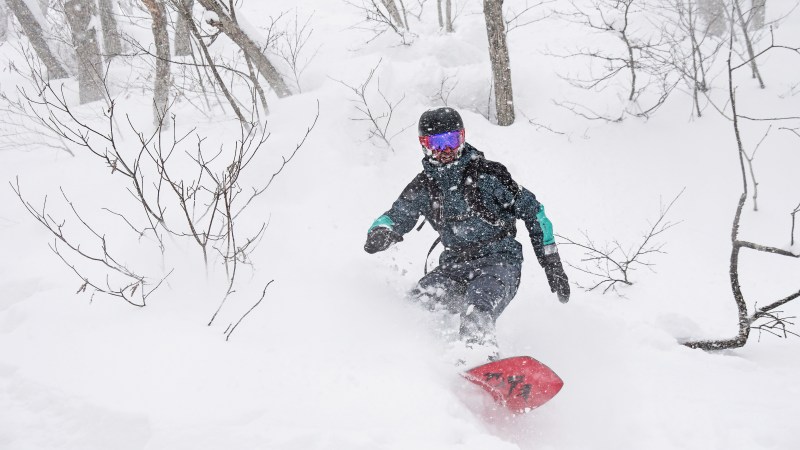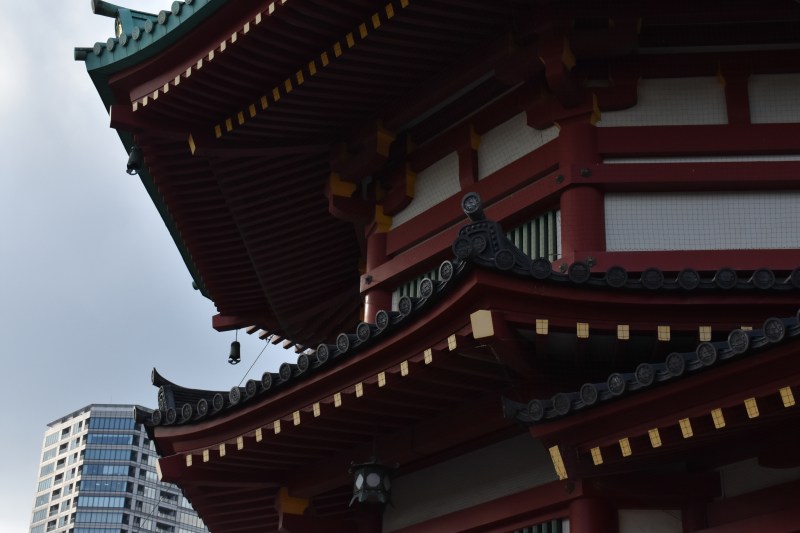
Any powder hound worth their salt knows the legend of Japow: A place that accumulates so much snow each year that people have to dig down to find their roads, and where snowboarders routinely don a snorkel to deal with the face shots. You can’t always open the front door because it dumped so much snow overnight. Could it really be as good as it was billed?
To find out, a small crew of us went to Japan snowboarding for a month in February. The Hakuba Valley promised nine ski resorts all on one pass with a mix of open runs, terrain parks, tree runs, and of course, deep powder. Over the course of the month, we hit the snow hard. We also hunted high and low for the best coffees and where to get a drink. Most importantly, we finally managed to understand the bus timetable. Here’s what we learned.
How to get to Hakuba
Most travel to Japan by flying into Tokyo, to either Narita or Haneda Airport. Like us, your hands might be tied with your airline or the day you’re heading in on; far more international flights land in Narita than in Haneda, which services the majority of Japan’s internal flights. The main difference is their proximity to Tokyo, with Narita being just over an hour on the train from the city center.
To get from the airport to Hakuba itself, we booked the Nagano Snow Shuttle. This was cheaper than the train and meant we didn’t have to carry our luggage through the station, but it did take just over five hours to get into the resort. If you want to get in a little quicker, take the train to Nagano and either another train or the bus into Hakuba.
Top tip: If you want to make your life really easy, you can have your ski bags sent from the airport to the resort. This takes a couple of days, though, so it’s best for those spending a day or two in Tokyo at the start of their trip. Alternatively, forgo the gear altogether and rent from Rhythm Rentals.

Where to stay in Hakuba
The most popular tourist spots in Hakuba Valley are either the Happo area, near the Happo-One lift, or Echoland and nearby Misolao. Both of these areas have great bars and restaurants, as well as access to plenty of rental shops and buses to reach other resorts. While the Happo area is right by a lift and the major bus terminal, Echoland is slightly further out, and you do have to take a bus to get to the resort.
When it comes to accommodations, you have a choice of everything from high-end luxury hotels and chalets to rentals for those on a budget. If you want to save yourself the headache of navigating the buses, look for accommodation that offers lifts to the resorts. Plenty of hostels will do this; they also offer breakfast so that you’re ready to hit the slopes each day. If you’re in self-catering accommodations, be aware that while there are convenience stores in both Echoland and Happo, the supermarket is driving-distance away and not serviced by buses.

Which resorts should you hit, how, and when?
Our first few days skiing in Japan were spent hitting all the major resorts in the valley. We didn’t go to Jigatake or Sanosaka, as these are more family-oriented resorts. We planned the day accordingly after checking out our weather and snow apps each night. Here’s what we found:
- Happo-One: The highest resort and the easiest to get to. The lower slopes were often busier and tracked into soft moguls, but the top was generally great riding. On bluebird days, Happo-One has incredible views, and the pistes are soft to hit. If it snows during the day, Happo-One fills back in faster than the other resorts.
- Happo 47 & Goryu: Two easy-access resorts on one day pass, Happo 47 and Goryu run their own buses from Echoland and Happo bus terminal. They feature a good mix of terrain, with Happo 47 having an excellent terrain park and tree runs on offer. Just note that the tree run requires you to attend a brief course and watch a safety video at the resort.
- Iwatake: The lowest resort, but you can ride a full 360º off the top of the mountain. We tended to go here on the sunny, slushy days for a cruise, but there are good tree runs and a great black run that feels like a huge natural halfpipe. Great for a half-day.
- Tsugaike Koken: Tsugaike is all about the trees. You’ll have to stop in at Jackie’s Kitchen to get your DBD pass that grants you access to the backcountry gates, which in turn will grant you access to the tree runs. We ended up in a couple of gulleys here, so watch where you’re going, and don’t get carried away.
- Cortina and Norikura: Seen as the place to go on a powder day, and these two resorts — on one ticket — have perhaps the best terrain and access to powder. They do get tracked out quickly, though, so Cortina is worth getting up early to be at the front of the queue. Norikura has a new chair that requires backcountry gear and isn’t always open. but it offers some great powder and excellent terrain.
The buses were one of the more challenging parts of the trip. Multiple companies operate there, and each has its own timetable. While the local buses are free, the buses run by Alpica, generally those going out to Cortina and Tsugaike, cost ¥520 — around $4 — unless you have a valley pass. The biggest issue we found was getting to Tsugaike and Cortina on a powder day, as the buses in Echoland started operating too late to get the first bus over. Instead, we left our accommodation at 6:30 and hiked the 40 minutes to be at the front of the queue. If you find yourself powder hunting like this, don’t worry — you won’t be alone.

What about when you’re not snowboarding?
No trip to Japan is complete if you don’t take in a little of the culture. I’m something of a cultural philistine, but other than the Ninja Museum, which was closed, there were a few cultural experiences I couldn’t miss.
- Zenko-Ji Temple: We added this to the end of a day visiting the Togakushi shrines outside Nagano, which I also recommend. The Zenko-Ji Buddhist temple was the hub of the village that became modern-day Nagano, and the street immediately downhill from the temple has a selection of street foods to try. The bus from Happo to Nagano cost ¥2000 — around $15 — and took just over an hour.
- Jigokudani snow monkeys: These Japanese macaques spend their days hanging out in the hot springs and swinging through the trees in the snow. The easiest way to see the monkeys is to book a tour; Rhythm Rentals runs daily tours you can go on. Alternatively, hop on the bus to Nagano again and then either another bus or train to Jigokudani; ask at the bus station if you’re not sure.
- Visit an onsen: Beware! No bathing suits are allowed in the onsens. Onsens are segregated into male and female visitors, if that makes you feel any better. Once you’re in, you’ll realize that no one really cares that you don’t have any clothes on, so relax and let your muscles soak in one of the many onsens in Hakuba.
- Try the food: Whether it’s a steaming bowl of ramen, a mound of rice and katsu curry, or street vendor yakitori (skewered chicken), the food is almost as good as the snowboarding. One of the best ways to try out a load of different foods is to head to an Izakaya bar, where you sit cross-legged around a table and they serve small dishes, tapas style, alongside beers.

Don’t miss out on heading to Tokyo
We spent the last three days of our trip in Tokyo. You can either visit the city at the start or end of your trip, but you definitely shouldn’t pass up the opportunity to visit one of the busiest places in the world. You can pick up a subway pass for ¥1500 — about $11.50 — for 72 hours, and this gets you all around the city. We stayed in Shinjuku, the tourist hub, and found we had no trouble getting anywhere we needed to go.
Be sure to visit some of the many temples, the Shibuya crossing, and the tiny bars of the Golden Gai region in Shinjuku, where you can just about squeeze in eight people. Or just lap up the insanity that is Tokyo. Check out the techno wonders of being served by a robot in a restaurant or take to the streets of Harajuku, where the fashion is unique, to say the least. Whateveryou do, just don’t miss Tokyo.



